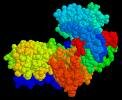PS3 Folding Approaching Historical Proportions
Published by Robert Staehlin April 26th, 2007 in Tech, Sony, PlayStation 3. Sony Computer Entertainment Inc. today announced that great progress has been made in the one month since PLAYSTATION 3 (PS3 ) computer entertainment systems became part of Stanford University’s program, a distributed computing project aimed at understanding protein folding, misfolding and related diseases. Since the program launched in March, participation by the PS3 user community has been phenomenal, providing with immense computing power that is helping to fast forward its research. Furthermore, thanks to PS3’s powerful Cell Broadband Engine (Cell/B.E.), the program has become one of the most powerful distributed computing networks in the world and is quickly approaching a level of computing power that is of historical proportions.
Sony Computer Entertainment Inc. today announced that great progress has been made in the one month since PLAYSTATION 3 (PS3 ) computer entertainment systems became part of Stanford University’s program, a distributed computing project aimed at understanding protein folding, misfolding and related diseases. Since the program launched in March, participation by the PS3 user community has been phenomenal, providing with immense computing power that is helping to fast forward its research. Furthermore, thanks to PS3’s powerful Cell Broadband Engine (Cell/B.E.), the program has become one of the most powerful distributed computing networks in the world and is quickly approaching a level of computing power that is of historical proportions.
Exhibiting its continued commitment to the program, SCE also announced that starting tomorrow, it is providing a application update that will further enhance the user experience. The updated software features an improvement in folding calculation speeds, increased visibility of user location (*1) on the globe and the ability for users to create longer donor or team names.
“The PS3 turnout has been amazing, greatly exceeding our expectations and allowing us to push our work dramatically forward,” said Vijay Pande, Associate Professor of Chemistry at Stanford University and program lead. “Thanks to PS3, we have performed simulations in the first few weeks that would normally take us more than a year to calculate. We are now gearing up for new simulations that will continue our current studies of Alzheimer’s and other diseases.”
Some of the key accomplishments made since the program launched on PS3 include:
More than 250,000 unique PS3 users have registered to the program in just one month. PS3 users are delivering nearly 400 teraflops, achieving a total computing power of over 700 teraflops at a single moment. This is more than double the computing capacity of the network before PS3 joined the program (*2). The “halo-effect” of PS3 has been evident as the number of active PCs has increased by 20 percent in the last month.
“We continue to be thrilled with the ongoing contributions of the PS3 user community in helping the program study the causes of many different diseases that afflict our society,” said Masayuki Chatani, Corporate Executive and CTO Computer, Sony Computer Entertainment Inc. “As we move forward, we are issuing a call to action for all PS3 owners around the world to download the application and help this cause. These PS3 fans can also be part of history as the distributed computing program inches closer to achieving a petaflop – a measure of computing power that has never before been reached.”
PS3 users can download the new update version 1.1 by restarting the application. New users can join the program by simply clicking on the icon within the Network menu of the XMB (XrossMediaBar) or can optionally set the application to run automatically whenever the PS3 is idle (*3).
Starting with , SCE will continue to support distributed computing projects in a wide variety of academic fields such as medical and social sciences and environmental studies through the use of PS3 and hopes to contribute to the advancement of science.
(*1) User location by IP address.
(*2) Based on Stanford University’s internal data, collected at the end of April.
(*3) To run the application automatically in idle state, PS3 must be connected to the network with both the main power switch and power button turned on. Option setting must also be changed as this automatic feature is off at default.
Source: Sony
0 Responses to “PS3 Folding Approaching Historical Proportions”
Please Wait
Leave a Reply